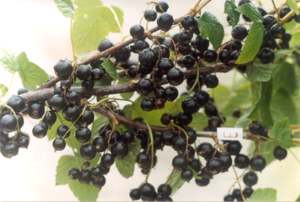Relatives
Ribes nigrum L. - Black currant.
Taxonomic position.
Family Grossulariaceae Hill, genus Ribes L., subgenus Coreosma (Spach) Jancz.Morphology and biology.
Perennial plant. Erect deciduous shrub, 1.0-1.5 m tall; on Alpine rocky deposits, this shrub is shorter, spreading, with raised branches. The bark is light yellow on annual branches, gray on biannual ones, and gray-brown or gray-purple on older ones. Leaves have 3 or fewer (frequently 5) triangular lobes with sharply serrated edges (the middle lobe is the longest); leaves have dark green upper surface and grayish green underside covered by sessile, amber glandules; leaves are fragrant, with an emarginate base and downy stalk. Racemes are short, oliganthous, with a pubescent axis and lanceolate bracts. Ovaries and berries have amber glandules. Sepals are elongated, downy on both sides or, predominantly, on the bottom surface. Hypanthium is saucer-shaped or cylindrical, pubescent, gray or greenish gray. Petals are white or pale yellow, narrow-elliptical, shorter than sepals by 1/3. Berries are black or dark brown, glossy, fragrant, 8-13 mm in diameter. Produces hybrids with other species of the same genus, including R. procumbens Pallas and R. graveolens Bunge. The rhythm of seasonal development is variable in different parts of the habitat. Blossoms in May/June; bears fruit in July/August. Monoecious, entomophilous, zoochore. Shade-tolerant mesophyte. Propagated mainly by seeds.Distribution.
Distributed throughout Europe from northern Spain to the Urals and the northern part of Western Siberia; Northeastern China; the United States and Canada; Australia (Southern Australia and Tasmania); and countries of the former Soviet Union (northern and central regions of the European part, Western and Eastern Siberia, Kazakhstan and the Far East).Ecology.
Occurs among brushwood on the banks of ponds, forest brooks, streams and rivers, on rocky deposits and damp woody stony slopes, predominantly in the forest and forest-steppe zones.Utilization and economic value.
Used for food and as a source of vitamins. Berries and leaves are rich in ascorbic acid (up to 4%) and vitamins P, A and B. Also used as a medicinal plant to control avitaminosis. In folk medicine, berries are used to treat anemia and cough, to stimulate appetite, and as a diaphoretic for colds. Leaves possess phytoncid activity and are used as a diuretic, diaphoretic, sudorific and anti-rheumatic agent. Leaves and buds are utilized in the food and alcoholic beverage industries. Berries are widely processed in food production for syrups, jams, kissels, jellies, pastila, confectionary filling, multi-vitamin drinks, liqueurs and fruit wines.References:
Areas of medicinal herbs and related plants in the USSR: An Atlas. 1990. Leningrad: Leningrad State University Publishers, p. 54.Bocharnikova N.M. 1973. Black Currants in the Far East. Vladivostok, pp. 34-48.
Komarov V.L. 1939. Flora of the USSR. Vol. 9. Family Saxifragaceae. Moscow/Leningrad, USSR Academy of Sciences Publishers, pp. 254-255.
Koropachinsky I.Yu. 1983. Woody plants of Siberia. Novosibirsk: Nauka, pp. 196-197.
Pavlova N.M. 1936. Currant and gooseberry. Cultivated Flora of the USSR. Vol. 16. Moscow/Leningrad, pp. 21-133.
Peshkova G.A., ed. 1994. Siberian Flora. Vol. 7. Berberidaceae-Grossulariaceae. Novosibirsk: Nauka, p. 214.
Vulf E.V., Maleyeva O.F. 1969. Worldwide resources of useful plants. Food, fodder, industrial, medicinal and others. Leningrad: Nauka, p. 178.


